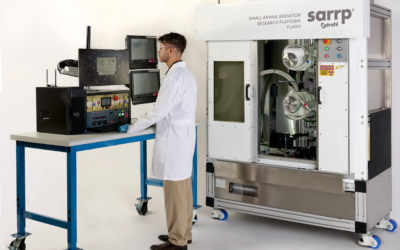
Poor survival rates of patients with tumors arising from or disseminating into the brain are attributed to an inability to excise all tumor tissue (if operable), a lack of blood-brain barrier (BBB) penetration of chemotherapies/targeted agents, and an intrinsic tumor radio-/chemo-resistance. Ataxia-telangiectasia mutated (ATM) protein orchestrates the cellular DNA damage response (DDR) to cytotoxic DNA double-strand breaks induced by ionizing radiation (IR). ATM genetic ablation or pharmacological inhibition results in tumor cell hypersensitivity to IR.
In their paper “The brain-penetrant clinical ATM inhibitor AZD1390 radiosensitizes and improves survival of preclinical brain tumor models.” Durant ST, Zheng L, Wang Y, Chen K, Zhang L, et al report the primary pharmacology of the clinical-grade, exquisitely potent (cell IC50, 0.78 nM), highly selective [>10,000-fold over kinases within the same phosphatidylinositol 3-kinase-related kinase (PIKK) family], orally bioavailable ATM inhibitor AZD1390 specifically optimized for BBB penetration confirmed in cynomolgus monkey brain positron emission tomography (PET) imaging of microdosed 11C-labeled AZD1390 (Kp,uu, 0.33).
AZD1390 blocks ATM-dependent DDR pathway activity and combines with radiation to induce G2 cell cycle phase accumulation, micronuclei, and apoptosis. AZD1390 radiosensitizes glioma and lung cancer cell lines, with p53 mutant glioma cells generally being more radiosensitized than wild type. In in vivo syngeneic and patient-derived glioma as well as orthotopic lung-brain metastatic models, AZD1390 dosed in combination with daily fractions of IR (whole-brain or stereotactic radiotherapy) using the Xstrahl SARRP significantly induced tumor regressions and increased animal survival compared to IR treatment alone.
The paper established a pharmacokinetic-pharmacodynamic-efficacy relationship by correlating free brain concentrations, tumor phospho-ATM/phospho-Rad50 inhibition, apoptotic biomarker (cleaved caspase-3) induction, tumor regression, and survival. On the basis of the data presented here, AZD1390 is now in early clinical development for use as a radiosensitizer in central nervous system malignancies.
This Xstrahl In Action was adapted from a article found on a National Library of Medicine website.






